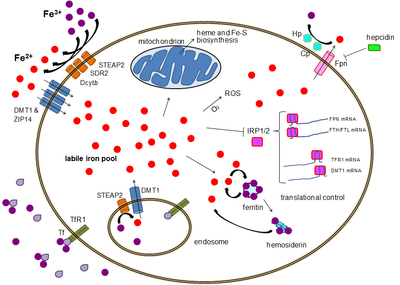
Back أيض الحديد لدى الإنسان Arabic Metabolisme humà del ferro Catalan Eisen-Stoffwechsel German Metabolismo humano del hierro Spanish Métabolisme du fer French Metabolismo do ferro humano Galician Zat besi ID Metabolismo del ferro Italian Dat wesi JV 사람의 철 대사 Korean

Human iron metabolism is the set of chemical reactions that maintain human homeostasis of iron at the systemic and cellular level. Iron is both necessary to the body and potentially toxic. Controlling iron levels in the body is a critically important part of many aspects of human health and disease. Hematologists have been especially interested in systemic iron metabolism, because iron is essential for red blood cells, where most of the human body's iron is contained. Understanding iron metabolism is also important for understanding diseases of iron overload, such as hereditary hemochromatosis, and iron deficiency, such as iron-deficiency anemia.